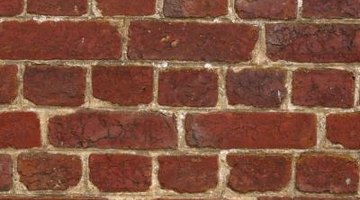R-Value for Brick vs. Wood
Brick and wood are both very common structural elements in buildings but offer relatively little insulating power. These materials can provide significant insulation if used in large quantities, producing a very thick wall. However, most structures augment their insulating ability using fiberglass, cellulose or other more insulative materials. Their R-values, which measure these materials' ability to keep heat inside or outside a home, vary depending on the type of brick or wood and the way it's used.
Brick

Brick's insulative value varies significantly depending on the type of brick. Four-inch common brick has an R-value of about 0.8, or 0.2 per inch. Four-inch face brick is much denser and has an R-value of about 0.44 per brick, or a little more than 0.1 per inch. In older brick homes, where the brick provides structural support, the wall is usually made up of two thicknesses of brick with an air space between them. This provides greater support and somewhat increases the brick's insulative ability, as long as the walls are well-sealed. Homeowners can spray insulation into the gap between these bricks to reduce heat loss.
Brick Cladding
Most brick homes built after the mid-20th century don't include brick as a structural element. Instead, these homes are made with brick cladding, a single layer of brick fastened over a wood or steel support structure. These bricks may be full thickness, or they can be a much thinner brick veneer.
Both types provide less insulative power than structural brick, due to their reduced thickness. Builders leave a relatively small space behind the brick cladding -- about ¾ inch, according to the Ask the Builder website. This space can be insulated using a spray-in material, which provides somewhat more insulative power than brick cladding alone.
Wood
According to the US Department of Energy, most softwoods, including pine, cedar and redwood, have an R-value of about 1.41 per inch of thickness. Most hardwoods have an R-value of about 0.71 per inch, due to their greater density. This gives a log wall 6 inches thick an R-value of a little over 8 -- not enough to satisfy most building codes without additional insulation. Adding windows and doors can decrease that value further.
Thermal Mass
R-value isn't the only measurement that affects heat transfer. Large masses of wood or brick tend to have some thermal mass and can store heat, increasing their effective insulating power. For instance, the DoE says that wood's thermal mass increases its effective R-value by about 0.1 per inch of thickness. Brick, being heavier, has greater storage capacity than wood. Thermal mass works best in mild, sunny climates with a significant difference between night and day temperatures.
References
Writer Bio
G.D. Palmer is a freelance writer and illustrator living in Milwaukee, Wis. She has been producing print and Web content for various organizations since 1998 and has been freelancing full-time since 2007. Palmer holds a Bachelor of Arts degree in writing and studio art from Beloit College in Beloit, Wis.
Photo Credits
- Hemera Technologies/AbleStock.com/Getty Images
More Articles



